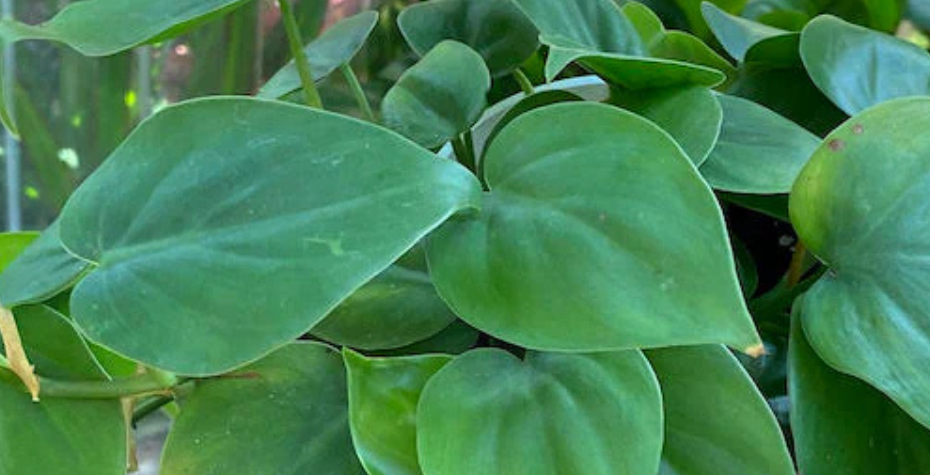 Image 1 of 1
Image 1 of 1


Philodendron hederaceum 'Heartleaf'
Philodendron hederaceum 'Heartleaf'
The Sweetheart Plant
The Ultimate Beginner's Companion
The Heartleaf Philodendron stands as the crown jewel of houseplants for one undeniable reason: it forgives your mistakes while rewarding your efforts with stunning, cascading beauty. Hailing from South America, Central America, and the Caribbean, heartleaf philodendrons are leggy tropical plants that have earned their reputation as exceptionally easy houseplants to care for. With glossy, heart-shaped leaves that dance gracefully from trailing vines, this plant transforms any space into a living work of art.
Why This Plant Rules Your Indoor Jungle
The magic of the Heartleaf Philodendron lies in its incredible adaptability. Whether you're a serial plant killer or a seasoned green thumb, this beauty meets you where you are. Its lustrous, deep green foliage creates instant drama when cascading from shelves, adds vertical interest climbing moss poles, or provides gentle movement in hanging displays. The plant's forgiving nature means it bounces back from neglect while thriving under attentive care.
The Science of Superior Growth
What sets exceptional Heartleaf Philodendrons apart is their propagation method. Tissue culture (TC) propagation produces plants with multiple growth points, superior root systems, and complete freedom from pests and diseases. This scientific approach ensures your plant begins its journey with optimal vigor, establishing faster and growing more robustly than conventionally propagated specimens.
Caring for Your Heartleaf: The Essentials
Light Requirements: Your Heartleaf Philodendron performs best in bright, indirect light but showcases remarkable tolerance for various lighting conditions, including medium to low indirect light. Avoid harsh, direct sunlight which can scorch those beautiful leaves and cause permanent damage.
Watering Wisdom: The key to watering success is consistency without obsession. Water when the top 1-2 inches of soil feel dry to the touch, allowing the soil to dry slightly between waterings. In shadier locations, these plants can often go two weeks or more without water, making them ideal for busy lifestyles or frequent travelers. Always use room temperature water and ensure your pot has drainage holes. Yellowing leaves typically indicate overwatering, while crispy edges suggest underwatering.
Soil and Potting: The Heartleaf Philodendron thrives in well-draining, rich, and slightly acidic soil, ideally with a pH between 5.5 and 6.5. Create the perfect growing medium by combining high-quality potting soil with perlite for drainage and a touch of peat moss for moisture retention. Repotting is typically only needed every two to three years, making maintenance refreshingly simple.
Humidity and Environment: While adaptable to average household humidity, your Philodendron will reward you with lusher growth in more humid conditions. Moist air will help lead to larger leaves and faster growth. Consider grouping plants together, using a humidity tray, or occasional gentle misting to create a more tropical environment.
Feeding for Optimal Growth: During the growing season (spring and summer), feed your plant with a balanced liquid fertilizer diluted to half strength once monthly. This provides essential nutrients without risking fertilizer burn. Reduce or eliminate feeding during fall and winter when growth naturally slows.
Growth Patterns and Training: This plant can develop very long stems, offering incredible versatility in display options. Regular trimming when stems become too long or scraggly encourages bushier growth and maintains your desired shape. The trimmed cuttings root easily in water, allowing you to propagate new plants effortlessly.
Pro Tip: For dramatic transformation, provide a moss pole or trellis. When aerial roots can anchor into damp sphagnum moss, the leaves gradually increase in size and develop more pronounced heart shapes, revealing the plant's true mature beauty.
Maintenance Made Simple: Keep leaves clean and glossy by gently wiping with a damp, soft cloth to remove dust and dirt, which not only maintains appearance but improves the plant's ability to photosynthesize effectively. Regular cleaning also helps you spot any potential issues early.
Troubleshooting Common Issues
Yellow leaves: Usually indicates overwatering. Allow soil to dry more between waterings and ensure proper drainage.
Brown, crispy leaf edges: Sign of low humidity or underwatering. Increase humidity and check your watering schedule.
Leggy, sparse growth: Insufficient light. Move to a brighter location with indirect light.
Slow growth: Normal during winter months, but can also indicate need for fertilization during growing season.
Pet Safety Statement
Please note: This plant is not pet-safe and can be toxic if ingested by animals. Keep out of reach of curious pets.
The Heartleaf Philodendron proves that sometimes the most beloved classics earn their status through pure, enduring excellence. It's an extremely easy to keep alive while providing maximum visual impact. Whether you're starting your plant journey or expanding an established collection, this remarkable species delivers consistent joy, lush beauty, and the satisfaction of successful plant parenting.
Philodendron hederaceum 'Heartleaf'
The Sweetheart Plant
The Ultimate Beginner's Companion
The Heartleaf Philodendron stands as the crown jewel of houseplants for one undeniable reason: it forgives your mistakes while rewarding your efforts with stunning, cascading beauty. Hailing from South America, Central America, and the Caribbean, heartleaf philodendrons are leggy tropical plants that have earned their reputation as exceptionally easy houseplants to care for. With glossy, heart-shaped leaves that dance gracefully from trailing vines, this plant transforms any space into a living work of art.
Why This Plant Rules Your Indoor Jungle
The magic of the Heartleaf Philodendron lies in its incredible adaptability. Whether you're a serial plant killer or a seasoned green thumb, this beauty meets you where you are. Its lustrous, deep green foliage creates instant drama when cascading from shelves, adds vertical interest climbing moss poles, or provides gentle movement in hanging displays. The plant's forgiving nature means it bounces back from neglect while thriving under attentive care.
The Science of Superior Growth
What sets exceptional Heartleaf Philodendrons apart is their propagation method. Tissue culture (TC) propagation produces plants with multiple growth points, superior root systems, and complete freedom from pests and diseases. This scientific approach ensures your plant begins its journey with optimal vigor, establishing faster and growing more robustly than conventionally propagated specimens.
Caring for Your Heartleaf: The Essentials
Light Requirements: Your Heartleaf Philodendron performs best in bright, indirect light but showcases remarkable tolerance for various lighting conditions, including medium to low indirect light. Avoid harsh, direct sunlight which can scorch those beautiful leaves and cause permanent damage.
Watering Wisdom: The key to watering success is consistency without obsession. Water when the top 1-2 inches of soil feel dry to the touch, allowing the soil to dry slightly between waterings. In shadier locations, these plants can often go two weeks or more without water, making them ideal for busy lifestyles or frequent travelers. Always use room temperature water and ensure your pot has drainage holes. Yellowing leaves typically indicate overwatering, while crispy edges suggest underwatering.
Soil and Potting: The Heartleaf Philodendron thrives in well-draining, rich, and slightly acidic soil, ideally with a pH between 5.5 and 6.5. Create the perfect growing medium by combining high-quality potting soil with perlite for drainage and a touch of peat moss for moisture retention. Repotting is typically only needed every two to three years, making maintenance refreshingly simple.
Humidity and Environment: While adaptable to average household humidity, your Philodendron will reward you with lusher growth in more humid conditions. Moist air will help lead to larger leaves and faster growth. Consider grouping plants together, using a humidity tray, or occasional gentle misting to create a more tropical environment.
Feeding for Optimal Growth: During the growing season (spring and summer), feed your plant with a balanced liquid fertilizer diluted to half strength once monthly. This provides essential nutrients without risking fertilizer burn. Reduce or eliminate feeding during fall and winter when growth naturally slows.
Growth Patterns and Training: This plant can develop very long stems, offering incredible versatility in display options. Regular trimming when stems become too long or scraggly encourages bushier growth and maintains your desired shape. The trimmed cuttings root easily in water, allowing you to propagate new plants effortlessly.
Pro Tip: For dramatic transformation, provide a moss pole or trellis. When aerial roots can anchor into damp sphagnum moss, the leaves gradually increase in size and develop more pronounced heart shapes, revealing the plant's true mature beauty.
Maintenance Made Simple: Keep leaves clean and glossy by gently wiping with a damp, soft cloth to remove dust and dirt, which not only maintains appearance but improves the plant's ability to photosynthesize effectively. Regular cleaning also helps you spot any potential issues early.
Troubleshooting Common Issues
Yellow leaves: Usually indicates overwatering. Allow soil to dry more between waterings and ensure proper drainage.
Brown, crispy leaf edges: Sign of low humidity or underwatering. Increase humidity and check your watering schedule.
Leggy, sparse growth: Insufficient light. Move to a brighter location with indirect light.
Slow growth: Normal during winter months, but can also indicate need for fertilization during growing season.
Pet Safety Statement
Please note: This plant is not pet-safe and can be toxic if ingested by animals. Keep out of reach of curious pets.
The Heartleaf Philodendron proves that sometimes the most beloved classics earn their status through pure, enduring excellence. It's an extremely easy to keep alive while providing maximum visual impact. Whether you're starting your plant journey or expanding an established collection, this remarkable species delivers consistent joy, lush beauty, and the satisfaction of successful plant parenting.
